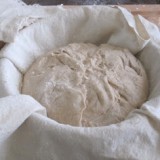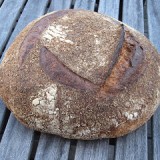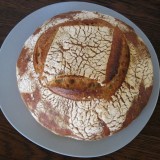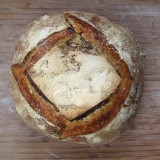
A recent “quarantine” loaf.
There are many paths up the holy mountain of sourdough bread baking. Wildly different methods will yield acceptable and edible results. But, no matter the method, I think one factor is important if you want to get a decent sourdough bread: the amount of time between feeding your starter and making your dough.
I keep a small amount of starter on hand since I bake, at most, twice a week under normal circumstances (Under quarantine I’m baking a lot more but the reasons for that would be the subject of another blog post). Just before I go to bed, the night before I’m going to make bread, I take a tablespoon of starer and add it to 50 grams of whole wheat flour and 60 grams of water. The next morning I have a little over 110 grams of starter with which to make my dough.

Starter float test.
Here’s the critical issue of timing: while I’m sleeping the sourdough culture is growing exponentially in the flour/water mixture. I need to make my dough within 8 to 12 hours of that feeding. If I wait too long the sourdough starter will lose its vigor. How do I know the starter is ready to use? I do a float test. If you gently spoon the culture into some water it should float, an indication that it’s active and full of CO2 bubbles. One of the most common mistakes with beginning sourdough bakers is not feeding the starter enough (you should feed at least once a day or put it in the refrigerator if you’re not going to use it) and trying to make a loaf with sourdough that’s been sitting too long after its last feeding.
To review my process:
- The night before I make bread I mix one tablespoon of starter with 50 grams of whole wheat flour and 60 grams of water.
- The next day I make up a dough and let it rise for approximate four hours at room temperature (this first rise is also called a bulk fermentation).
- After the four hour bulk fermentation, I shape the dough, put it in the refrigerator and bake the next day. This second period of fermentation is called “proofing”). I’ve found that putting the dough in the refrigerator to proof has a few advantages: it develops a richer flavor, the dough is easier to handle, it’s less likely to stick to the bread form, and you have flexibility in terms of when to bake the next day.
- When it’s time to bake I pull the dough out of the refrigerator and put it straight into a 475º F (246º C) oven.
So, in total, my bread baking process takes 2 days. You have to think ahead but there actually isn’t much work involved since I’m using a no-knead method. Again, it’s not the only way to make sourdough bread but I’ve found this method works well for me. For exact recipes and techniques I highly recommend the book Josey Baker Bread (library link). What I like about Josey’s book is that it’s kind of like a class in bread baking. He starts you out with simple loaves and then gets into more advanced techniques. There’s plenty of illustrations on top of the fact that Josey is a really nice dude (I’ve had the pleasure of meeting him).
If you’re interested in the details of my starter method I did a video about it.
Stay safe and happy baking! As Josey Baker says, “Make Awesome Bread – Share the Loaves!”




Timely! I was going to ask you about starter. I am following the instructions in Josey Baker Bread. When I have tried (and failed) to make a starter before, I was using bagged flour. Now, I’m using fresh-ground flour from my Mockmill. My initial starter fermented *overnight*. I did give it two days before feeding it again yesterday, but now I am wondering if I should feed it daily instead because the fermentation is happening so rapidly? Thoughts?
I thought I understood how dead bagged flour had become….now I really understand. My old starts didn’t really work because there wasn’t anything to work with. This is a completely different experience!
Any suggestions on where to get flour in LA? My normal supply of King Arthur flour has been tough to find.
Hey Nick–Roe at the King’s Roost is still doing bulk orders. The order form is here: https://kingsroost.com/bulk-grain-flour-order/. I got a fifty pound bag of grain last week that I’m working from but he’s also got a full selection of Central Milling flour in five and fifty pound bags which I like better than King Arthur (though King Arthur is fine).
I loved going back and reviewing your old videos and reading comments. I too have had problems using flour from the store shelf so now I am going to try a rye flour that I ground this morning. Hope that works! And in the past I felt bad about throwing out half every morning but today I read a comment that it is good for septic systems so happy about that. Like I said, I am trying rye flour so hope that works. Rye berries are what I have at the moment.
Haven’t tried it but you can, apparently, make fry bread with sourdough starter: https://www.youtube.com/watch?v=vVx2oFFptG0.
By the way there is an article in the SFGate about people sharing sourdough starter via baggies hung on the telephone poles with note saying its name is Godrich.
Awesome!
Thanks so much for this. I’ve been working on my first starter and your advice led to a successful loaf.
https://share.icloud.com/photos/0C91rBJjW9khl7Z5yM38Eubbg
Nice looking loaf!
What is with the insane amount of salt in the Josey Baker Bread book? I just tried making my first loaf following the instructions and 12g of salt absolutely wrecked my dough. I knew as I was adding it that it couldn’t be right….totally confused….I’ll start again tomorrow, but disappointed.
What kind of salt did you use? Did you use a scale? Average salt in most bread recipes is around 2% (as measured against the total amount of flour). I just checked some of Josey’s recipes and they are around 2.6% salt. I remember, when he came down here, him saying something about liking a slightly higher salt level. I would recommend using sea salt and a scale. Reduce to 2%. Don’t go too much below that as bread tastes really bad if there isn’t enough salt.
I used Diamond Krystal kosher salt, which is the least salty of the salts and used a scale. There is such a massive difference between two teaspoons and 12g! I may take a picture….